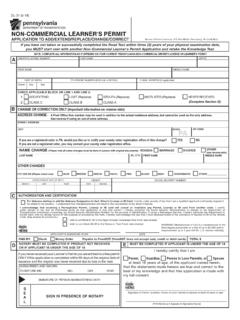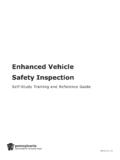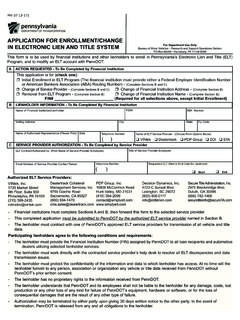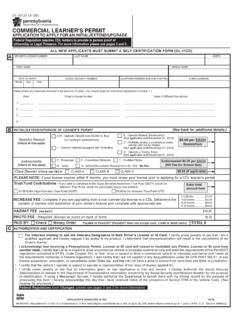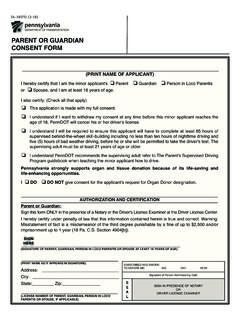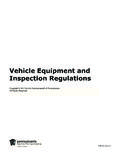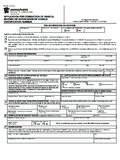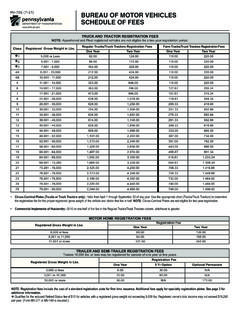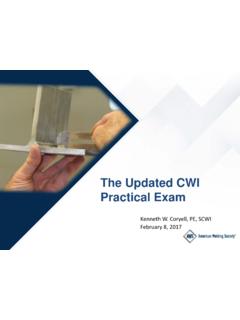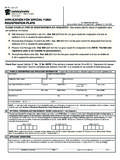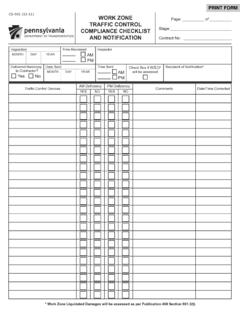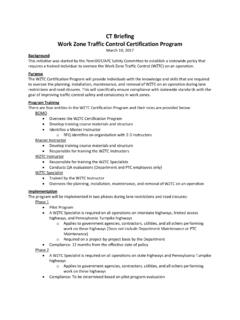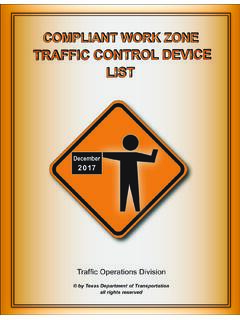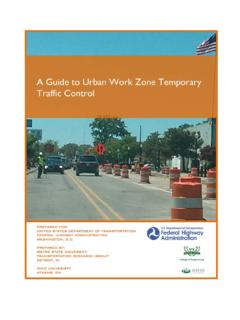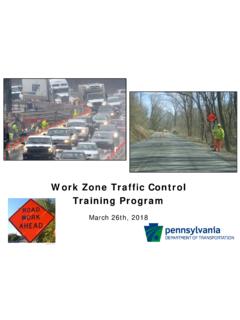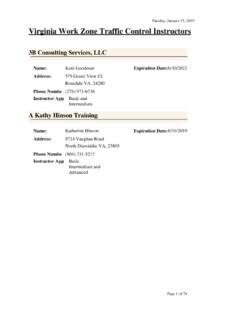Transcription of PUB 208 (7-10) - dot.state.pa.us
1 Pennsylvania work ZonePocket Guide forMunicipalities & UtilitiesPUB 208 (8-10)2 Introduction & ReferencePrimary Useful Resources ..5 Worker Safety ConsiderationsWorker Safety Key Safety Safety Zone Device GuidelinesTTC Zone Size and Placement Device and Adjusting Typical ApplicationsPATA Figure Application Figure Figure 11e ..33 PATA Figure for Zone Checklist for Short Term Set-upsPlanning / for Handbook was developed for use by persons involved in maintenance, construction, or utility work onor along Pennsylvania s roadways. The intention is thatthis Pocket Guide will serve as an accessible source ofinformation covering common conditions work crewsmay encounter. While no single document can providethe breadth and depth of information necessary to coverevery potential condition encountered along every segment of roadway in the Commonwealth, this document has been developed as a handy reference for most applications needed under most information in this Pocket Guide was compiled fromavailable resources including PennDOT and FederalHighway Administration publications, and is intended toillustrate the guidelines for proper work zone traffic control , but is not a standard.
2 Each of these publications addresses facets of temporary traffic control issues in greater depth than presented here. Each section of this Pocket Guide indicates the source of the material presented, offering users a convenient reference. In those specificinstances where a real condition is unusual and not covered here, these publications are available for additional review and study. Introduction & Reference5 The publications consulted in developing this Handbookare listed Resources Manual on Uniform traffic control Devices(MUTCD), Federal Highway Administration PUB 212, Official traffic control Devices, Pennsylvania Department of Transportation PUB 213, Temporary traffic control Guidelines, Pennsylvania Department of TransportationOther Useful Resources PUB 35, Approved Construction Materials (Bulletin 15), Pennsylvania Department of Transportation PUB 46, traffic Engineering Manual, Pennsylvania Department of Transportation PUB 234, Flagging Handbook, Pennsylvania Department of Transportation PUB 236M, Handbook of Approved Signs, Pennsylvania Department of Transportation PUB 408, Standard Specifications6 PUB 213 defines workers as a person on foot whoseduties place him or her within the right-of-way of a streetor highway, pathway, such as a highway constructionand maintenance forces, survey crews, utility crews, responders to incidents within the highway right-of-way,and law enforcement personnel when directing traffic , investigating crashes, and handling lane closures, obstructed roadways, and disasters within the right-of-way of street, highway, or pathway.
3 Worker Safety - Key ElementsThese key elements of worker safety should be considered by TTC planners: Worker training Worker safety apparel Properly placed temporary traffic barriers Reduction in the speed of vehicular traffic Properly planning the activity area Conduct a basic hazard assessment of the work areaWorker Safety Considerations7 Worker Safety ImprovementsIn addition to following MUTCD and PUB 213 TTC requirements, there are several options available to improve worker safety. These include: Shadow vehicle; Road closure; Law enforcement; Lighting; Special devices such as: - rumble strips, - changeable message signs, - beacons, - flags, and, - warning lights (MUTCD ).8 Worker Safety - ApparelGuidance on safety apparel for all workers can be foundin both the MUTCD and in PUB 213 requires safety apparel for workers on Penn-sylvania roadways. In the General Notes section, notenumber 9, PUB 213 reads: All workers including flaggers shall wear a high-visibility fluorescent orange or yellow-green apparel with retroreflective material that meets the latest ANSI/ISEA publication entitled AmericanNational Standard for High-Visibility Safety Appareland Headwear for Class 2 risk exposure anytimeday or night.
4 Class 3 high-visibility should be considered for additional flagger visibility at inclement weather, high-visibility fluorescentrain gear may be used. If FHWA amends or modified their regulation, the amendment will take effect on the date specified by FHWA. Example: ANSI Class 2 Safety Apparel is available in many styles and materials9 TTC Zone DevicesChapter 6F of the MUTCD contains guidance about thedevices used in Temporary traffic control (TTC) , TTC devices include: signs; channelizing devices such as cones, drums and barricades; and lighting. For Pennsylvania-specific TTC devices, refer to: PUB 212 - Official traffic control Devices; PUB 213 Temporary traffic control Guidelines; PUB 236M - Handbook of Approved Signs. Sign supports shall be crashworthy, must be PennDOT approved vendors, and listed in PUB 35 (Bulletin 15). This publication is updated regularly, so it is best accessed online at: Zone Device Guidelines10 Sign Size and ColorTemporary signs must follow PennDOT s convention forsize and color.
5 Maintaining such standards assists roadusers with quick recognition and helps form expectationsfor appropriately approaching temporary traffic controlzones. From PUB 213: All signs shall be 36 x 36 for conventional roadways; The ROAD work AHEAD sign (W20-1) or ROAD work NEXT __ MILES (G20-1) signs are the standard advance signs. These signs may be used as alternatives: - EMERGENCY AHEAD (W25-1), - SURVEY CREW (W21-6), - MOWING NEXT __ MILES (W21-14), and - BRIDGE INSPECTION AHEAD (W21-11);11 Sign Placement GuidelinesSigns should be located on the right side of the roadwayunless otherwise specified, however supplemental signsmay be placed on left side of the roadway. Signs are tobe placed at right angles to roadway. When placing temporary signs, visibility of existing roadway featuresmust be maintained. Do not obstruct view of existingtraffic control devices, and consider hills and sharp turnsand their impact on sign visibility. Also, do not obstructsight distance from driveways or : Sign Obstructing Sight Distance from a Park Driveway12 Avoid placing signsbehind curves andobstructionsAvoid placing signsin intersections orother conflict of appropriate sign placementExample of poor sign spacing and placement14 Many roads will have situations that require the use of judgment in sign the queues (line of vehicles) extend beyond the advanced signing for the work zone, additional signing may be appropriate and is required on higher speed highways (PUB 213 note 31).
6 15 Sign LayoutGuidance regarding sign layout within temporary trafficcontrol zones is found in PUB 213. PATA Sign Layout isthe page within PUB 213 that shows the standard lateraldimensions of sign layout, with typical dimensions forboth rural and urban roadways. Also included on thatpage are notes regarding sign layout: Signs located on both the left and right sides of the roadway shall conform to these guidelines. Higher mounting heights are desirable and may be necessary where construction equipment, material, or other obstructions such as parking or pedestrian activity are present. In urban areas, a clearance of 1 from the curb face is permissible where sidewalk width is limited or where existing poles are close to the curb. Within work zones , it is sometimes necessary or desirable to position signs within the roadway itself. All signs erected within a roadway or a shoulder shall be mounted on portable supports or Type III barricades.
7 Any supplemental plaque must also be centered under the sign. Portable sign supports shall only be used during short term from the PATA Sign Layout page in PUB 213 1. Signs located on both the left and right sides of a roadway shall conform with these guidelines. 2. Higher mounting heights are desirable and may be necessary where construction equipment, material, or other obstructions such as parking or pedestrian activity are present. 3. In urban areas, a clearance of 1 from the curb face is permissible where sidewalk width is limited or where existing poles are close to the curb. 4. Within work zones , it is sometimes necessary or desirable to position signs within the roadway itself. All signs erected within a roadway or a shoulder shall be mounted on portable supports or type III barricades. 5. The length of type III barricade rails shall equal or exceed the widest horizontal dimension of the widest sign installed on the barricade or a minimum of 4 whichever is larger.
8 6. The supplemental plaque may also be centered under the sign. 7. Portable sign support shall only be used during short term not block sidewalks/pathswith signsEdge of sign is 2feet from edge oftravel way21 PUB 213 permits the placement of signs within a roadway,as long as portable signs are mounted on approved breakaway supports. This sign is also placed in the parking lane, not the travel ofportable signmust be 1 footabove theheight of thepavementEdge of travel way22 Channelizing Device PlacementIn addition to the four components of a TTC zone, theMUTCD contains guidance about tapers, which may be used in transition and termination areas. Typically, a taper is a series of channelizing devices and/or pavement markings that move traffic out of or into thenormal traffic path. There are several types of tapers, including: Shifting taper; Shoulder taper; Merging taper; One lane, two-way traffic taper; and Downstream taper (MUTCD ).The lengths of tapers should be determined using thePATA drawings found in PUB 213 page 5 of this hand-book.
9 Generally, taper lengths are associated with thespeed of traffic and the lane width/shift, with lowerspeeds requiring shorter tapers and higher speeds requiring longer tapers23 PUB 213 specifies the required spacing for channelizingdevices in work zones . Rememberthat: a work zone has four main parts and device spacing is typically associated with - the particular segment of the work zone and - the posted speed limit or operating speed of the roadway (Speed).Below is a diagram showing the device spacing fora Typical Flagger Operation Devices minimumin TaperTaper Length100 Ft. Ft. Space Devices within Taper 20 Ft. in 100 Ft. Taper 10 Ft. in 50 Ft. TaperMax Device Spacing 1 X SpeedWhen setting up the taper, place the first and last devices in thetaper along the edge line or in the shoulder, lay-out the othercones evenly between those two, and then move the deviceslaterally into the lane to be closed, delineating the taper. 24 Flagger No. 2 Beginning of Terminationto flagger 100 Ft.
10 Area: 6 Devices Min. 100 Ft. Area Device Spacing: D Max. =2 X Speed 90 Ft. (45 MPH) Must Continue Past work Area45 MPH25 Using and Adjusting Typical ApplicationsThe MUTCD, Chapter indicates that the goal ofTTC in work zones is safety with minimum disruption toroad users. The key factor in promoting TTC zonesafety is proper 213, in its General Notes indicates that all dis-tances given in its typical drawings may be adjustedslightly to fit field conditions (Note 1). Further, TrafficControl Plans may deviate from the typical applicationsshown in the publication to allow for conditions and requirements of a particular site or jurisdiction (Note 3).Following are common issues or scenarios requiringtemporary traffic control . For each of these, a referenceto the appropriate guidelines is and Adjusting Typical Applications26 Following is PATA 10a showing the closing of one lane ofa two-lane roadway:27 Below is a table from PATA 10a showing channelizingdevice spacing based upon Highways except Freeway and ExpresswayMPHDE* are the NOTES from PATA 10a: 1.
